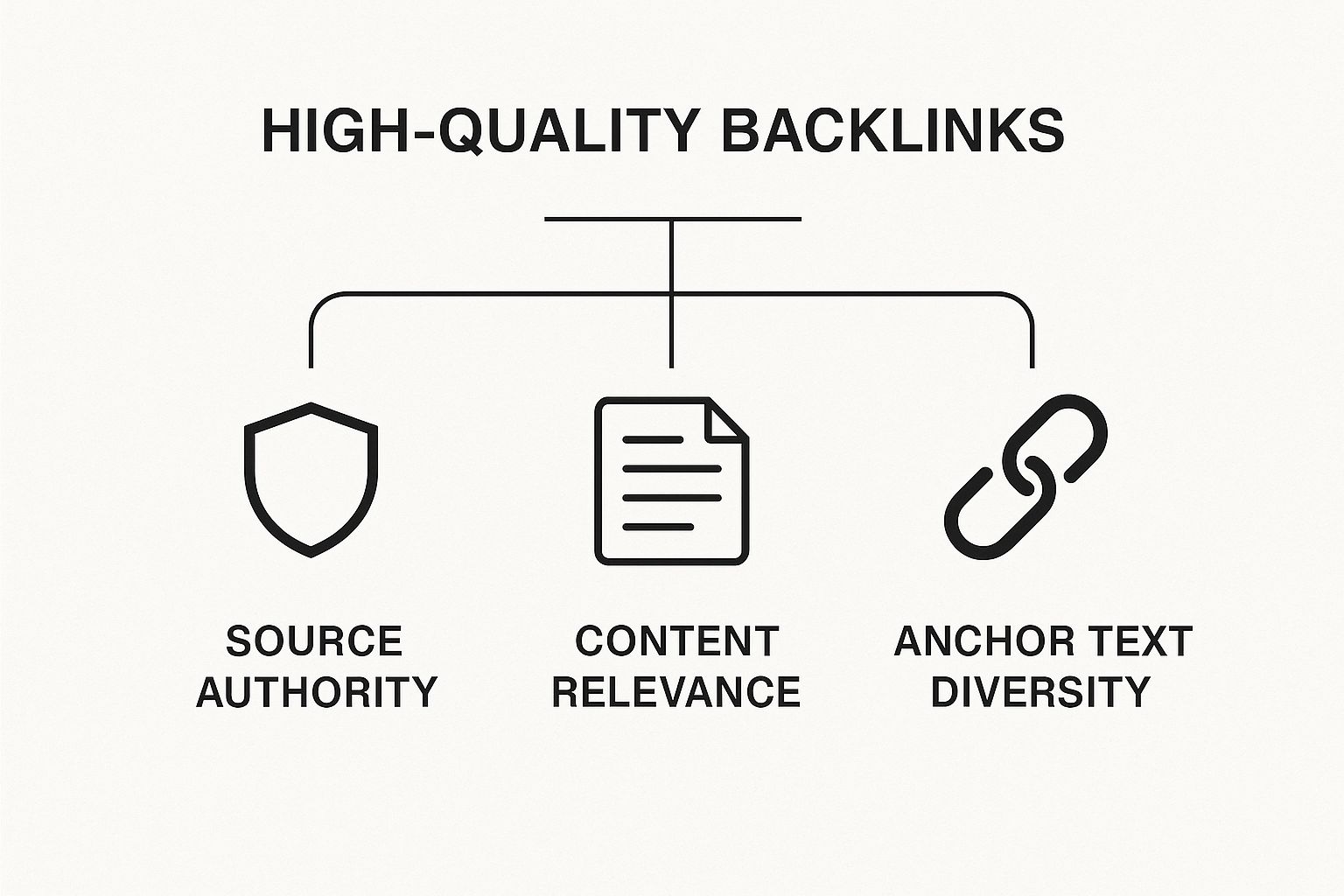Think of a high-quality backlink as a genuine vote of confidence from one website to another. It’s a signal to search engines that your content is credible, valuable, and worth paying attention to. But not all votes are created equal. A single link from a powerhouse, relevant site is worth more to your SEO than a hundred links from sketchy or unrelated sources. This single idea is the foundation of any modern, successful link-building strategy.
Why High-Quality Backlinks Are Your SEO Superpower

Picture the internet as one giant network of recommendations. When a well-respected website links to your content, it’s doing more than just sending traffic your way—it’s publicly vouching for you. Search engines like Google watch these endorsements like a hawk. A strong profile of high-quality backlinks is one of the most convincing signals you can send to prove your site’s authority and relevance.
This whole process is about building trust online. It’s a lot like real life. If you’re looking for a great new restaurant, who do you trust? A rave review from a world-renowned food critic carries a ton of weight. A flyer from a random person on the street? You’d probably ignore it. Backlinks work the same way. That link from a major industry publication or a top university website—that's the food critic’s review. It tells Google your site is a first-class destination for information.
Quality Over Quantity Is the Golden Rule
Years ago, some SEOs played a numbers game, trying to grab as many backlinks as possible, no matter where they came from. That era is over. Today, the game has changed completely, and the focus is squarely on earning links from reputable sources. This isn't just a "best practice"; it's a hard-and-fast rule among the pros.
A 2025 survey of link builders found that an overwhelming 93.8% agree that the quality of a backlink is far more important than the total number of links you get.
This shift is huge. It means one well-earned link from an authoritative site can deliver more SEO power than a thousand links from spammy directories. Chasing quantity is not only a waste of time but can also get you in hot water with Google, which actively penalizes sites for manipulative link schemes. Focusing on quality protects your site and builds a solid foundation for real, long-term growth. If you want to dive deeper into this, exploring the fundamental role of backlinks in SEO provides a great perspective.
High Quality vs Low Quality Backlinks at a Glance
To really hammer this point home, let's break down the key differences between the backlinks you want and the ones you need to avoid.
| Attribute | High Quality Backlink (The Goal) | Low Quality Backlink (The Risk) |
|---|---|---|
| Source Authority | Comes from a well-respected, authoritative site (e.g., industry leader, top news site, university). | Originates from a spammy, unknown, or penalized site. |
| Relevance | The linking site is in the same or a closely related niche as yours. | The content of the linking site is completely unrelated to yours. |
| Placement | Placed naturally within the body of high-quality, relevant content. | Found in spammy footers, comment sections, or low-value directories. |
| Anchor Text | Uses natural, relevant, or branded anchor text that fits the context. | Often uses over-optimized, "exact match" anchor text repeatedly. |
| Traffic | The link has the potential to send real, relevant referral traffic. | Sends little to no referral traffic, or the traffic is low quality. |
| Intent | An editorial endorsement, given because your content is valuable. | Acquired through payment, schemes, or manipulation, not merit. |
As you can see, the contrast is stark. One builds your reputation and rankings, while the other can tear them down.
The Direct Impact on Your SEO Performance
Earning high-quality backlinks has a direct and measurable effect on your ability to rank for the keywords that matter and pull in organic traffic. Every quality link you get adds to your site's overall "Domain Authority," which is basically a measure of its trustworthiness in the eyes of a search engine.
Here’s how that translates into real-world results:
- Improved Search Rankings: A powerful backlink profile is one of the main factors Google uses to rank pages. More quality links almost always lead to higher spots in the search results.
- Increased Organic Traffic: Better rankings mean more people see you, which naturally brings more clicks and visitors from search engines.
- Enhanced Brand Authority: When authoritative sites link to you, their credibility rubs off on your brand. You start to be seen as a trusted voice in your field.
Ultimately, building a strong backlink portfolio is a serious investment in your site’s future health and visibility. To see how these ideas fit into a bigger marketing picture, you might find some interesting reads over at the RebelGrowth blog.
The Anatomy of a Powerful Backlink
Let’s get one thing straight: not all backlinks are created equal. Far from it. To really figure out what separates the SEO powerhouses from the digital deadweight, we need to get under the hood and see what makes them tick.
Think of it like being a talent scout for your website. You're not just looking for any link; you're looking for the superstars that will propel you to the top. This isn't about racking up points on some tool. It’s about understanding the core signals of trust and relevance that a link sends to Google. A truly powerful backlink is a strategic asset, not just another number in a spreadsheet.
This graphic really breaks down the essentials of what we're looking for in a quality backlink.

As you can see, a link's true strength comes down to the authority of where it's from, how relevant it is to your content, and the natural mix of its anchor text.
The Power of Source Authority
First up, and arguably the most important piece of the puzzle, is the authority of the linking website. Think of it as a recommendation. A glowing review from a world-renowned expert in your field? That carries some serious weight. A random shout-out from a blog no one's ever heard of? Not so much.
In the world of SEO, we use a few key metrics to get a handle on this "reputation":
- Domain Authority (DA) from Moz
- Domain Rating (DR) from Ahrefs
Now, these are third-party metrics, not something Google uses directly. But they're fantastic proxies for a site's overall strength and trustworthiness. A link from a high-DA site like a major news outlet or a respected university is a powerful vote of confidence in Google's eyes.
A link from a domain that has never linked to you before is generally more valuable than multiple links from a site that has already linked to you. Search engines see the first link as a new endorsement, while subsequent links have diminishing returns.
The Undeniable Importance of Relevance
But authority isn't the whole story. The link also has to be topically relevant. It just makes sense, right? If you run a blog about vegan baking, a backlink from a famous vegan chef's website is a home run. A backlink from a blog about classic cars? That’s just plain weird and sends a confusing signal to search engines.
Google is smart enough to understand context. It wants to see that other sites in your "digital neighborhood" are vouching for you. This relevance reinforces your expertise and helps Google correctly categorize your website, making it much easier to rank you for the keywords that actually matter.
On-Page Factors That Matter
Beyond the site linking to you, the nitty-gritty details on the page itself play a huge role in a backlink's power. Getting these details right is how you squeeze every last drop of value out of your links.
1. Contextual Link Placement Where a link shows up on a page is a big deal. A link that's naturally woven into the main body of the content—what we call a contextual link—is the gold standard. It’s a clear signal that the link is an editorial choice, placed there to give the reader more valuable information.
On the other hand, links buried in footers, author bios, or sidebars carry way less punch. They feel less like a genuine recommendation and more like a paid placement or an afterthought.
2. Natural and Diverse Anchor Text Anchor text is simply the clickable text of a link. Ideally, it should be natural-sounding and give a clue about the page it's linking to. But here's a word of caution: over-optimizing by using the exact same keyword for your anchor text over and over is a massive red flag for search engines.
A healthy, natural anchor text profile has a good mix, including: * Branded anchors (e.g., "Outrank") * Partial match keywords (e.g., "backlink building strategies") * Naked URLs (e.g., "www.outrank.so") * Generic anchors (e.g., "click here" or "read this guide")
3. The Dofollow vs. Nofollow Attribute
Links can have a rel="nofollow" attribute, which is basically a note telling search engines not to pass any "link equity" or authority. While nofollow links aren't useless—they can still send traffic and build brand awareness—"dofollow" links are the ones that directly move the needle on your SEO rankings. When you're actively building links, your main goal is to acquire dofollow links.
And while you're focused on anchor text and domain authority, don't forget that the structure of the page you're linking to also matters. An effective URL strategy can amplify the power of the links you build.
Proven Strategies to Earn High Quality Backlinks

Knowing what a high-quality backlink looks like is one thing. Actually getting them is a whole different ballgame. You can't just cross your fingers and hope for the best; you need a proactive game plan filled with legitimate, sustainable tactics. The goal is to earn the kind of authoritative links that genuinely move the needle for your SEO.
This isn't about finding sketchy loopholes or chasing short-term hacks. It's about creating undeniable value and building real relationships in your industry. When you nail these proven methods, you'll find that earning high-quality backlinks becomes a natural side effect of great marketing.
Create Irresistible Linkable Assets
The absolute best way to get links is to create something that people genuinely want to link to. We call these "linkable assets," and they're the cornerstone of almost every successful link-building campaign. Instead of begging for a link, you create a resource so damn good that other site owners feel compelled to share it with their audience.
Think bigger than a standard blog post. A truly powerful linkable asset often comes in one of these forms:
- Original Research and Data: When you publish a unique study or survey with fresh stats, your site instantly becomes the primary source. Bloggers and journalists are always hungry for new numbers to back up their claims.
- The Ultimate Guide: A truly comprehensive, well-organized guide on a complex topic can become the definitive resource online. People will link to it because it’s the best place for their audience to learn more.
- Free Tools or Templates: A simple calculator, a handy checklist, or a useful template provides immediate value. These assets earn links because they solve a real, tangible problem for people.
The aim is to create something that is, without question, the "best-in-class" for its category. This is tough, but it pays off big time. In fact, one study estimates that a staggering 94% of all online content gets zero external backlinks, which just goes to show how critical it is to create something exceptional.
Master the Art of Guest Posting
Guest posting has a bit of a checkered past, but let’s be clear: when done right, it's still one of the most powerful ways to build authority and secure relevant links. The old-school method of churning out low-effort articles for any site that would take them is dead. Today, it’s all about strategic placement and delivering real value.
The modern goal is to contribute genuinely insightful content to reputable, topically aligned websites in your niche. You aren't just dropping a link; you're building a relationship, sharing your expertise with a new audience, and putting your brand in a context that reinforces its authority.
Think of it as strategic brand placement that also happens to come with a powerful backlink. Your focus should be on becoming a valued contributor to a relevant community, not just a one-off link builder.
To find the right opportunities, look for sites with a real, engaged readership that cover topics closely related to yours. Pitch them an idea that fills a clear gap in their content and offers obvious value to their audience. When you place your link, it should feel like a natural, helpful resource within the article—not a clunky, forced promotion.
Find and Fix the Web with Broken Link Building
Broken link building is a brilliantly effective strategy because it provides immense value to other webmasters while earning you a link. The process is surprisingly simple: you find a broken link (one that leads to a 404 error page) on a relevant website, you let the site owner know about it, and you suggest your own content as a worthy replacement.
This strategy works so well because you're leading with a helping hand. You aren't just asking for a favor; you're offering a solution to a problem that improves their site.
Here’s how the process usually breaks down:
- Identify Relevant Pages: Start by looking for resource pages or in-depth articles on authoritative sites in your industry—the kind that are likely to have long lists of external links.
- Scan for Broken Links: Use a browser extension like Check My Links to quickly scan the page for any dead links.
- Find a Suitable Replacement: If you already have a piece of content that's a perfect substitute for the broken resource, you're golden. If not, this is a fantastic opportunity to create a new asset tailored to fill that gap.
- Reach Out and Help: Send a friendly, non-pushy email to the site owner. Let them know you're a fan of their site and that you spotted a broken link while reading. In the same message, politely suggest your content as a helpful replacement for their readers.
By creating fantastic content and getting it in front of the right people, like journalists and influential bloggers, you can earn mentions and links on major publications. These mentions then amplify your reach to a much wider audience, creating a powerful flywheel effect. If you want to dive deeper, you can explore more ways to boost content and link building efforts to get even more tactical.
How to Vet and Qualify Your Link Prospects
Just getting links isn't enough. Knowing which opportunities are worth chasing is what separates the pros from the amateurs who spin their wheels on dead-end prospects. You need a solid, repeatable process to vet potential link partners. This ensures every single link you build adds clean, powerful authority to your site, not baggage.
Think of yourself as a detective sizing up a lead. You need to gather evidence, check their background, and make sure they’re legit before you make a connection. In the world of SEO, this means using the right tools and a bit of critical thinking to analyze a site before you even dream of sending an outreach email.
Your Core Vetting Toolkit
To kick off your investigation, you'll need the right gear. SEO platforms like Ahrefs, Semrush, or Moz are your magnifying glass. They help you look past a site's shiny homepage and see what's really going on under the hood, giving you the hard data you need to decide if a site is a golden opportunity or a toxic liability.
Your main goal is to answer one simple question: is a link from this site a genuine, authoritative vote of confidence? To figure that out, you'll need to dig into a few key areas.
Gauging Authority with DR and DA
The first, most common check is a site’s overall authority. This is usually measured with metrics like Domain Rating (DR) from Ahrefs or Domain Authority (DA) from Moz. Now, these are third-party scores—not something Google uses directly—but they're excellent proxies for a site's backlink strength and general reputation online.
A higher score is generally better. A site with a DR of 70 is almost always a stronger prospect than one with a DR of 10. But don't get hung up on small differences. The gap between a DR of 45 and 50 is far less important than other factors, like whether the site is even relevant to yours.
Analyzing Organic Traffic Trends
A site’s authority score doesn't paint the whole picture. You absolutely have to look at its organic traffic. A healthy, high-quality site should have a steady or growing stream of visitors coming from search engines. It's a sign of life.
Here’s what to look for in a traffic graph:
- Steady Growth: An upward trend is a fantastic sign. It shows the site is doing things right and earning Google's favor.
- Sudden, Sharp Drops: A dramatic nosedive in organic traffic is a massive red flag. This often signals a recent Google penalty for sketchy tactics. Back away slowly.
- No Traffic at All: If a site has a decent DR but gets virtually no organic traffic, something's fishy. It could be part of a private blog network (PBN) or another type of link farm built only to manipulate search rankings.
A website's traffic is its lifeblood. A site with strong authority but declining or non-existent traffic is like a beautiful, well-built house that nobody lives in. It looks good on the outside, but something is wrong internally.
Inspecting the Backlink Profile
Next, it’s time to look at who is linking to them. A site’s own backlink profile tells you a lot about the company it keeps. Are they earning links from respected industry players, or are they surrounded by digital riff-raff?
When you analyze their backlink profile, ask yourself these questions:
- Is it relevant? Are their links coming from other sites in their niche? Or is it a random, nonsensical mix?
- Is it spammy? Do you see thousands of junk links from foreign-language sites, sketchy forums, or spammy blog comments?
- Is it natural? Does their anchor text look varied and organic, or is it stuffed with the same exact-match keywords over and over again?
A clean profile with links from relevant, authoritative sources is a green light. A profile riddled with spammy, irrelevant links is a sign to stay far, far away.
For those looking to find pre-vetted opportunities, exploring a curated marketing and SEO tools directory can be a great starting point to identify potential partners. This due diligence ensures every high-quality backlink you acquire strengthens your digital foundation.
Common Link Building Mistakes to Avoid
 When you're chasing high-quality backlinks, knowing what not to do is just as important as knowing what to do. One wrong move can torch your time and budget, or worse, get you penalized by search engines. It's a tricky game, and it's easy to get tempted by shortcuts that promise a quick win.
When you're chasing high-quality backlinks, knowing what not to do is just as important as knowing what to do. One wrong move can torch your time and budget, or worse, get you penalized by search engines. It's a tricky game, and it's easy to get tempted by shortcuts that promise a quick win.
Let's be real: effective link building is hard. That’s probably why even though nearly 80% of SEOs see it as a critical strategy, 52.3% of digital marketers also say it’s the toughest part of the job. This difficulty explains why so many fall into the same common traps. You can read up on more link building statistics to get the full picture.
The Danger of Over-Optimized Anchor Text
One of the most common—and riskiest—mistakes is getting obsessive about anchor text. This happens when you try to make every single backlink use your exact target keyword as the clickable text. It sounds smart in theory, but to search engines like Google, it’s a massive red flag.
Think about how people link to things naturally. They use all sorts of phrases: a brand name, a simple "click here," or a descriptive sentence about the content. A backlink profile where every anchor text is an identical, keyword-stuffed phrase just screams "unnatural and manipulative." This is the kind of thing that can trip an algorithm like Google Penguin and send your rankings into a nosedive.
Avoiding Toxic Shortcuts and Link Schemes
The promise of fast results can lead you down a dark path of toxic link-building tactics. These shortcuts are direct violations of search engine guidelines and can wreck your site's reputation for years to come. The most infamous of these is the Private Blog Network (PBN).
A PBN is a web of websites created for the sole purpose of linking out to a main "money" site. They're designed to look like real, independent blogs but offer zero value to actual readers. Google has gotten incredibly good at sniffing out these networks, and when they do, the penalties are swift and severe—often wiping out a site's organic traffic overnight.
Other schemes to run from include: * Buying links: Paying for placement on low-quality sites that are essentially link farms. * Excessive link exchanges: Getting caught in large-scale "you link to me, I'll link to you" schemes. * Automated link-building software: Using programs that blast your link across forums, blog comments, and directories.
The rule of thumb is simple: If a link opportunity seems way too easy or too good to be true, it’s probably a toxic shortcut you should avoid. Real authority is earned through merit, not bought through manipulation.
The Mistake of a Homepage-Only Focus
Another classic blunder is pouring all your link-building energy into your homepage. Your homepage is obviously important, but your most valuable, detailed content usually lives deeper inside your site—on your blog posts, guides, and resource pages. Links to these pages, often called "deep links," are incredibly powerful.
When another site links directly to one of your specific articles or guides, it sends a strong signal to Google that this particular piece of content is a credible, valuable resource. This helps those pages rank for their own specific long-tail keywords. A healthy backlink profile has a natural mix of links to the homepage and these internal pages, showing the true breadth and depth of your site's expertise. If you're only building links to your homepage, you're leaving a ton of SEO power on the table.
Let's stop talking theory and get down to what really matters. A strong backlink profile isn't just some abstract SEO concept; it has a direct, measurable impact on your business. We're talking about turning your SEO efforts into tangible results like higher rankings, more traffic, and a brand that people actually respect.
It's the difference between shouting into an empty room and being the keynote speaker everyone wants to hear.
Think of it like building a competitive moat around your business. When you've laid a foundation of high-quality backlinks, it becomes incredibly difficult for your rivals to push you out of those top spots on Google. While they're scrambling on shifting sand, your business is sitting on a rock-solid foundation of credibility and trust.
From Links to Leads
Here’s where the real magic happens. A killer backlink profile kickstarts a self-sustaining growth engine for your business. Higher rankings mean more visibility. More visibility brings in a steady stream of organic traffic. And that traffic turns into potential customers, leads, and—you guessed it—more sales. It's a straight line from a quality link right to your bottom line.
This isn't just wishful thinking; the numbers tell the story. Pages that hit the number one spot on Google have, on average, 3.8 times more backlinks than the pages sitting in spots two through nine. That stat, which you can read more about in this breakdown of link building value from Sixth City Marketing, shows just how massive an advantage a deep backlink profile really is.
A great backlink profile doesn't just help you rank; it protects your rankings. It acts as a powerful barrier to entry, forcing competitors to invest significant time and resources just to catch up, let alone surpass you.
Investing in high-quality backlinks is a cornerstone of any serious digital strategy. It’s not just an SEO box to tick; it’s a core business activity that cements your brand's authority and secures its place in the digital world for the long haul.
If you're ready to build a backlink profile that creates that competitive moat and drives real growth, you can start your journey with RebelGrowth today. We give you the network and expertise to earn the authoritative links that will insulate your business and fuel its success.
Of course. Here is the rewritten section, designed to match the natural, expert tone of the provided examples.
Your Top Backlink Questions, Answered
As you start your link building journey, you're bound to have questions. It's a complex part of SEO, after all. Let's tackle some of the most common ones I hear, so you can move forward with a clear head and a solid game plan.
How Many High-Quality Backlinks Do I Actually Need?
There’s no magic number here. Honestly, anyone who gives you a specific count is guessing.
Instead of chasing an arbitrary number, your focus should be on competitive relevance. The real goal isn't hitting a specific target; it's about building a stronger, more trusted backlink profile than the pages you're trying to outrank.
So, where do you start? Take a look at the top three to five competitors for your main keyword. This gives you a realistic benchmark to aim for. A slow and steady stream of a few great links each month is way more powerful—and sustainable—than a sudden flood of mediocre ones.
Can I Get Penalized for Building Backlinks?
Yes, but only if you’re using sketchy, manipulative tactics that violate search engine guidelines. This is the stuff that gets websites in trouble: buying spammy links in bulk, getting involved with link farms, or using private blog networks (PBNs).
But if you stick to the white-hat strategies we've been talking about—earning links because you have fantastic content, doing genuine outreach, and building real relationships—your risk is practically zero. Modern link building is about earning endorsements, not faking them. That approach keeps your site safe and builds authority that lasts.
The core idea behind safe link building is simple: create value first. A link should be a natural side effect of providing something so useful or authoritative that another site owner is happy to point their audience to it. This mindset is your best protection against penalties.
How Long Does Link Building Take to Show Results?
Link building is a marathon, not a sprint. It’s a long-term investment in your site's authority, and patience is absolutely essential. It takes time for search engines to find new links, crawl the pages, and for that value to get passed along.
Generally, you might start to see some positive movement in your analytics within 3 to 6 months of consistent work. But for those significant, lasting ranking improvements? That often takes 6 to 12 months or even more. The key is persistence. Treat link building like an ongoing marketing activity, not a one-and-done project.
Ready to build a powerful backlink profile that drives real growth? rebelgrowth provides the tools and network to earn the authoritative links that will elevate your business. Get started with RebelGrowth today.
